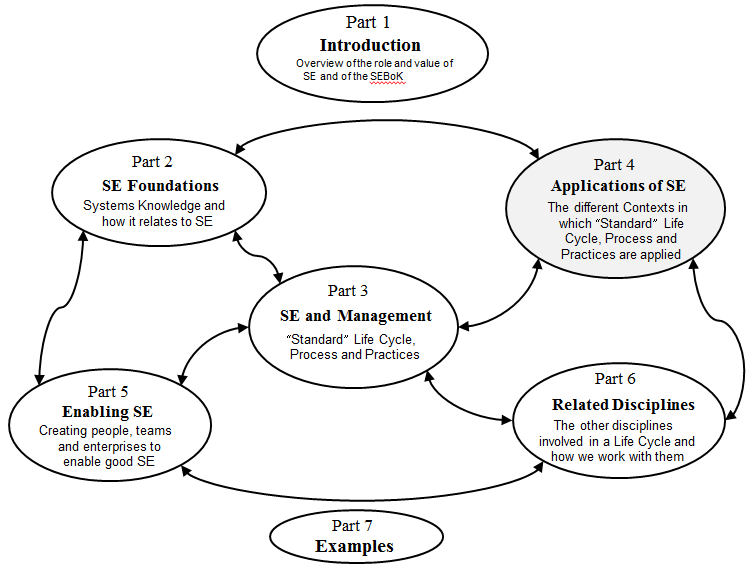Applications of Systems Engineering
Part 4 of the Guide to the SE Body of Knowledge (SEBoK) focuses on the application of systems engineering to the creation and life cycle management of various types of systems.

In particular, the part covers product systems, service systems, enterprise systems, and system of systems (SoS). It also contains a knowledge area describing Healthcare SE as a domain extension of these general SE approaches. This is the first of a number of planned domain based extensions.
Knowledge Areas in Part 4
Each part of the SEBoK is divided into knowledge areas (KAs), which are groupings of information with a related theme. Part 4 contains the following KAs:
- Product Systems Engineering
- Service Systems Engineering
- Enterprise Systems Engineering
- Systems of Systems (SoS)
- Healthcare Systems Engineering
Systems Engineering Application
The different ways in which each of these contexts shapes the application of the generic SE Life Cycle and Process knowledge in Part 3 is discussed in detail in the KA above.
It is important to note that none of the context above is intended to be wholly separate or mutually exclusive from the others. They should be seen as overlapping and related frameworks which provide a starting point for how generic SE might be used to fulfil real world needs. We might think of each as a model of how SE can work in the real world. Each gives advice on how to use generic SE life cycle and process knowledge against its own viewpoint. If necessary, each may also develop new or extended knowledge relevant to its context, which becomes part of the extended toolkit of SE. Like any set of models, each has its own simplifications, strengths and weaknesses. As a general principle we would always select the simplest model available which fits the purpose and use that. For a complex outcome the combination of a number of models may be needed.
The real world application of SE is no different. In most real projects combinations of Product, Service, Enterprise and SoS knowledge may be needed to achieve success. The extent to which these combinations are taken from pre-determined approaches vs the need for systems engineers to create such combinations are part of the application of SE is a key question for how SE is used. The final part of this knowledge, on how SE is applied in the real world, sits within the knowledge base of the various application domain. Some domains have a very detail set of procedures, guidelines and standards relevant to that domain, while others take general SE and apply it as needed using the judgement of those involved. In general, all domains have a little of both domain specific guidelines and experienced people. The SEBoK was originally written to be domain independent, other than through the application examples in part 7. To complete the SEBoK we intend to create a series of Domain Application KA. These will give an overview of how SE application maps to domain practice. They are aimed at both the general SE reader who wants to know more about a domain and those working within a domain.
The Healthcare SE KA contained in this version of the SEBoK is the first such domain specific extension of the SEBoK.
References
Works Cited
None
Primary References
None.
Additional References
None.
SEBoK Discussion
Please provide your comments and feedback on the SEBoK below. You will need to log in to DISQUS using an existing account (e.g. Yahoo, Google, Facebook, Twitter, etc.) or create a DISQUS account. Simply type your comment in the text field below and DISQUS will guide you through the login or registration steps. Feedback will be archived and used for future updates to the SEBoK. If you provided a comment that is no longer listed, that comment has been adjudicated. You can view adjudication for comments submitted prior to SEBoK v. 1.0 at SEBoK Review and Adjudication. Later comments are addressed and changes are summarized in the Letter from the Editor and Acknowledgements and Release History.
If you would like to provide edits on this article, recommend new content, or make comments on the SEBoK as a whole, please see the SEBoK Sandbox.
blog comments powered by Disqus